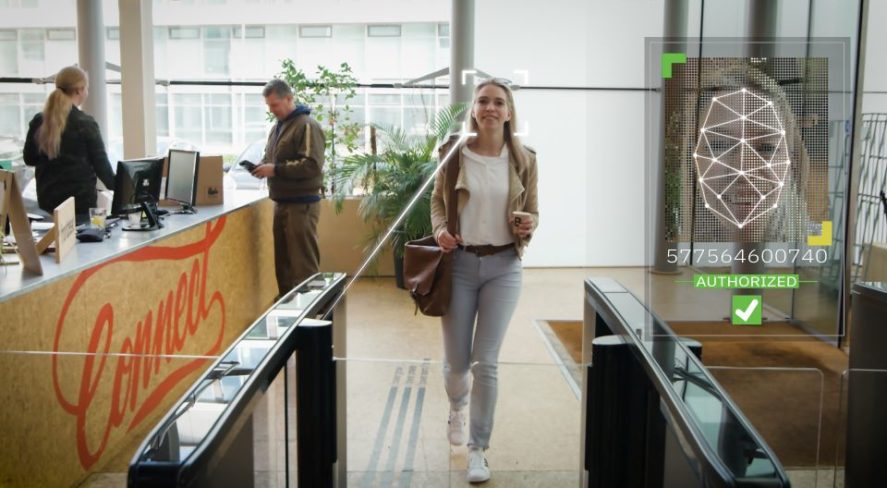Touchless Entry Is Here to Stay: How Modifications to Building Access Promote Both Security and Safety


The COVID-19 pandemic has had an immense impact on nearly every aspect of our lives, including how people interact and perform their jobs and even how buildings are designed. The goal of all these changes? Reducing human-to-human contact and, thus, slowing or stopping the spread of the virus. As a result, businesses are challenged to find new ways to open their doors again while providing a hands-free entry experience – all without compromising security.
As organizations develop return-to-work plans, there are several common and necessary security requirements, including “future-proof” designs that support social distancing and touchless entry. The changes made to a building or campus design because of the pandemic should not be temporary. Instead, they should fulfill the organization’s needs for years to come.
Why Is Controlling Access Important?
A prerequisite to discussing a new lobby design with increased safety and security in the post-pandemic world is examining why it is critical for organizations to control access in the first place. What would happen if an unauthorized person were to infiltrate a building’s lobby? The potential risks and liabilities include, but are not limited to:
- Theft
- Loss of productivity
- Violence
- Loss of life
- Civil lawsuits based on a failure to fulfill “duty of care”
- Regulatory fines for noncompliance (HIPAA, NERC, etc.)
While organizations often deploy various physical security solutions (guards, access control systems, cameras) in an attempt to mitigate unauthorized entry, if these technologies are used in conjunction with swinging doors, then infiltration is still possible. “Tailgating” occurs when someone presents a valid credential at a swing door, opens it, and either holds the door open for others or is followed by an unauthorized person who “catches” the door before it closes and gains access.
When it comes to mitigating tailgating and unauthorized entry, building designers and security professionals must answer two key questions to decide on the appropriate physical security strategy for a facility:
- Who is in the building at any given moment?
- How many unauthorized people are acceptable in the facility?
Answering these questions reveals an organization’s stance on tailgating. Do they want to deter it? Detect it? Or completely prevent it? And it is acceptable to have more than one strategy – a layered approach – across multiple areas of a building or campus. For instance, security professionals may want to deter tailgating at the fence line, or outer perimeter, detect tailgating in the lobby, and prevent tailgating on an upper-level floor holding restricted data or records.
Sophisticated security revolving doors and turnstiles provide significant benefits over traditional swinging doors in that they effectively mitigate tailgating while also reducing the burden on the people and processes needed to keep a building secure. This allows guards to focus on visitors, rather than on monitoring the lobby.
Changes in Design Post-Pandemic
When planning a lobby for a post-pandemic landscape, there are two key design elements to consider:
- Assessing the building population and creating separate entry and exit points
- Supporting and reinforcing distance by design
Every organization funnels different types of people through their building or campus. Some lobbies process only employees while others handle both employees and visitors. Some buildings are open to the public and others might receive deliveries in the lobby. The lobby tends to be a multi-functional space utilized by a large variety of people. And, while traditional security strategies endorse a single, secured entry point for controlling access, today’s “new lobby” requires multiple entry and exit points as a means of reducing congested, two-way traffic by spreading people flow across the entire building.
The first step to creating separate entry and exit points is to identify and categorize the building population, then determine where and how each set of users should enter the building. For instance, can employees be directed to separate employee-only entrances so that the lobby can be used just for visitors and deliveries? Is there an opportunity to funnel employees through different entrances around the building, like office workers through the left side and factory workers through the right? Should packages be received at the back of the building rather than in the main lobby?
Another consideration is designing the flow of people to support and reinforce social distancing. There may be an opportunity to space out work areas, eliminating open office layouts in favor of more private cubicles or small offices. Designers can position furniture to provide multiple ways of moving through a building. And if office layouts cannot be adjusted, organizations may consider increased telecommuting and flexible on-site work schedules. For example, 50 percent of the population works in the office on Monday and Tuesday and the other 50 percent comes in on Wednesday and Thursday.
Rethinking Existing Security Technologies
There are a variety of security technologies that have been used in building design for decades – access control systems, cameras, elevator dispatch systems, the list goes on. It is common knowledge that these technologies are not silver bullets; users cannot just choose one or two, install them, and alleviate security risks. Technologies must be deployed in layers and work in concert with people and processes to effectively control access. This approach still applies when it comes to the new lobby design.
Below are three technologies that have gained popularity in the new lobby for their ability to support social distancing, scan for symptoms, and “virtualize” entrance processing.
Touchless Entry
When it comes to entrances, touchless technologies are nothing new. We have seen automatic sliding and swinging doors installed in buildings across the globe for many years. With the new lobby, touchless entry is no longer optional. It is important that users touch door handles, buttons, etc. as little as possible. And, an essential requirement, the new lobby design must provide an automated entry experience without compromising on security.
When COVID-19 began and the requirement for touchless environments became urgent, many facility managers started researching ways to make all entrances automatic. A popular solution was retrofitting existing manual swing doors with low-energy, electric operators, which are typically used with wide doors for disabled access. While this can be an easy and quick fix, these automatic swing doors do not stop unauthorized entry from tailgating.
Automatic security revolving doors, mantrap portals, and turnstiles allow contactless entry without compromising security. It may not be practical to replace every swing door with an automatic security entrance, but one can consider how to deploy security doors and turnstiles as part of a layered physical security strategy at certain entry points across a building.
It is worth noting that security entrances approve or deny access based on the data they receive from an access control system. While scanning an RFID employee badge or proximity card at a turnstile is a very common way of entering a building, there are other credential or identity verification technologies today that support touchless entry, including facial recognition, iris recognition, hand-wave technology for contactless fingerprint scanning, and Bluetooth on mobile phones.
Temperature Screening
An existing technology that has received a lot of attention in the new lobby design is thermal imaging. By placing a thermal camera in the lobby and asking employees and guests to pass by it to check for an elevated body temperature, it may be possible to screen for a virus symptom. But, while a fever may be an indicator of a sick person, it also may not be. Researching the symptoms of any virus(es) affecting the local area will help determine if this technology could be an effective means for keeping staff safe.
There are some critical things to keep in mind regarding the use of thermal cameras for body temperature screening:
- Ineffective for mass scanning. According to the Food and Drug Administration (FDA), thermal imaging systems are not accurate when used to screen multiple people at the same time.
- Reduces throughput. Using thermal cameras can significantly slow down traffic in the lobby.
- Requires a new process. What happens if a screen shows that somebody has an elevated body temperature? What is the process? Who will carry it out?
Upfitting Security Entrances
Security entrances are an effective way to deter, detect and prevent unauthorized entry from tailgating. While automatic security doors and turnstiles are effective touchless entry solutions, there are ways to make manual entrances a bit safer for users, as well. Note that all entrances are hardware that can be outfitted with antimicrobial finishes or special films to control germs and kill microbes on contact.
Manual Tripod and Full-Height Turnstiles
Tripod and full-height turnstiles require users to touch and push through the entrance to gain access to a secure area. Sleeves and braces are now available that allow users to enter by pushing with their forearms instead of their hands. Manual turnstiles require 24/7 supervision since they do not have sensors and can be defeated by jumping over the arms or by two people piggybacking in a full height compartment. These solutions work best when used in conjunction with other security technologies, such as cameras and access control systems, and as the first “deterrence” layer in a physical security plan.
Automatic Optical Turnstiles
Optical turnstiles are automatic solutions that can be outfitted with touchless credential readers for hands-free entry. To support social distancing, some organizations design and install a large array of optical turnstiles to handle building traffic, then restrict use to every other lane. This method enables building and designing for long-term needs by installing a complete turnstile array, while also addressing immediate health and safety concerns.
Automatic Security Revolving Doors and Mantrap Portals
Security revolving doors and mantrap portals can provide the highest level of security by preventing tailgating without the need for manned observation. They, too, are automatic entrances that can be furnished with touchless credential or identity verification devices, allowing users to simply approach and proceed into the entrance while tailgaters are reliably excluded.
Short and Long-Term Planning
When designing or redesigning a lobby, consider what design elements and technologies can be used to reduce interpersonal contact and the potential spread of infection. Features should support both touchless entry and social distancing and should be able to stand the test of time, with the flexibility to offer new solutions should the need arise. Many technologies exist today that can be deployed quickly to make buildings both safe and secure.
Greg Schreiber is senior vice president of sales at Boon Edam.
